I know I haven’t blogged in a while, but here is a special post about a great mistress: Françoise-Athénaïs.
Françoise-Athénaïs was the mistress to the Sun King himself; Louis XIV of France. Born on October 5th, 1641 and baptised the day at the Chateau of Lussac Chateaux, Françoise – later adopted the name “Athénaïs”. Françoise possessed the blood of two of the oldest noble families of France through her parents, Gabriel de Rochechouart, Duke of Mortemart, Prince of Tonnay-Charente, and Diane de Grandseigne.
Athénaïs was considered breathtakingly beautiful by the standards of her time. She had thick, curly wheat-colored hair that fell in ringlets around her face so beautifully that even the Queen copied her hairstyle. Her eyes were huge and blue, her lips full and her figure sensuously curvaceous. All of these qualities appealed to the sensibilities of beauty at the time. Her love of mockery, infectious laughter and quick wit were engaging, as were her intelligence and flirtatious interplay. Steeped in sensualism, she is often described as a hedonist with a fondness for music, dancing, the arts, food and love-making. She had an extravagant and demanding nature and possessed enough charm to usually get what she wanted. She was expensive and glorious, like the Palace of Versailles itself. Her apartments were filled with pet animals and thousands of flowers; she had a private gallery, and costly jewels were showered upon her. She was highly discriminating as regards to the quality of the gems; returning them if they did not meet her exacting standards. She was given the nickname Quanto (“How much”, in Italian). Her love for food and her numerous pregnancies caused her to gain weight in her late thirties until her pleasingly plump figure became undesirably fat.
Françoise-Athénaïs was the maid-of-honour to the king’s sister-in-law, Princess Henrietta Anne of England, who was known at court by the traditional honorific of Madame. Later, because of the relationship between her mother and the queen dowager, Anne d’Autriche, Françoise-Athénaïs was appointed to be a lady-in-waiting to the king’s wife, Marie-Thérèse d’Autriche.
On 28 January 1663, Françoise married Louis Henri de Pardaillan de Gondrin, Marquess of Montespan (1640–1701), who was a year older than she was. Françoise had previously been engaged to his brother, but the brother had been killed in a duel after a ball at the Louvre. After his death, it was decided that Françoise should marry his younger sibling. The wedding ceremony took place in a chapel at the Église Saint-Eustache in Paris. The couple had two children: Marie Christine de Pardaillan de Gondrin and Louis Antoine de Pardaillan de Gondrin, Marquess of Antin.
| The couple lived in a small house close to the Louvre, which allowed Madame de Montespan to attend court and carry out her duties there as a lady-in-waiting to the Duchess of Orléans. Beauty was only one of Madame de Montespan’s many charms. She was a cultured and amusing conversationalist, who won the admiration of such literary figures as letter-writer Madame de Sévigné and diarist Saint-Simon. In addition, she kept abreast of political events. This had the effect of making her even more appealing to men of intellect and power. | |||
| Madame de Montespan astounded the court by openly resenting the position of queen Marie-Thérèse d’Autriche,[5] the daughter of the king and queen of Spain, Philip IV and Elisabeth de France. A scandal arose when the Duchess of Montausier, governess of the royal children and lady-in-waiting to the queen, was accused of acting as a go-between in order to secure the governorship of the Dauphin for her husband, the Duke of Montausier. By 1666, Madame de Montespan was trying to take the place of Louis XIV’s current mistress, Louise de La Vallière. Using her wit and charm, she sought to ingratiate herself with the king. She also became close to the Dauphin, whose affection for her never wavered. | |||
The first of the seven children that Madame de Montespan bore to the king was born in March 1669. The new-born child, a girl, Louise Françoise de Bourbon (1669–1672), was entrusted to one of Madame de Montespan’s friends, Madame Scarron (the future marquise de Maintenon) to raise. The King bought a small house in the village of Vaugirard on the outskirts of Paris. In 1673, the couple’s three living illegitimate children, given the royal surname of de Bourbon, were legitimatised by Louis XIV. Their mother’s name, however, was not mentioned in the legitimisation documents. This was because Madame de Montespan was still married to the marquis de Montespan at the time. If their maternal parentage had been revealed, the marquis could have claimed Madame de Montespan’s illegitimate children with the king as legally his own. The eldest, a son, Louis-Auguste de Bourbon, became the duc du Maine; the second child, a son, Louis-César de Bourbon, became the comte de Vexin; and the third, a daughter, Louise-Françoise de Bourbon, became Mademoiselle de Nantes. As Madame de Montespan spent the majority of her time immersed in the social whirl of the court, the three had little contact with their busy mother and spent most of their childhood with their governess, Madame Scarron.










